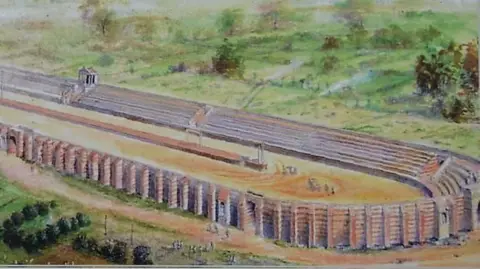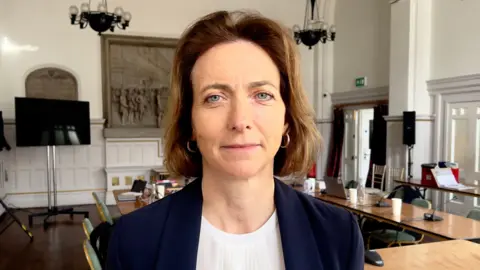Leaders rally to protect Roman chariot track
 Colchester Archaeological Trust Limited
Colchester Archaeological Trust LimitedKey figures have united to ensure that development plans complement the site of Britain's only known Roman chariot racing track.
The Roman Circus was identified during excavations at the former Colchester Garrison in 2004 and was probably in full use between the 2nd and 3rd Century, according to the Colchester Archaeological Trust.
A coalition of politicians and business leaders have signed a letter addressed to the planning inspector ahead of a planning inquiry.
Labour MP for Colchester, Pam Cox, said: "We can't rebuild the circus, obviously, but you can rebuild a sense of the scale of it."
The planning inquiry began at the town hall on Tuesday morning.
Plans to build more than 200 homes on the former Army Base Repair Organisation land were refused last November over concerns of the impact they would have on the appearance and character of the underground site.
 Google
GoogleThe Roman Circus has been described by the trust as a "unique archaeological monument", first discovered in 2000 and identified four years later.
The trust said the track was 450 metres (1,476ft) long and about 74 metres (243ft) wide, and would have had six tiers of seating for more than 8,000 spectators.
It was probably constructed on the orders of Emperor Hadrian, who visited Britain in the year 122 CE.
Current development plans include building housing around the site and recreating the gates.
In an update on Tuesday, Colchester City Council said "enhancements" had since been made to the scheme's design.
It meant the authority would no longer defend one of its grounds for refusal.
Martyn Warnes, chair of the planning committee, said: "The revised scheme offers improved architectural quality and a more respectful approach to the site's historic context."
 John Fairhall/BBC
John Fairhall/BBCMs Cox said the plans needed "a sense of the scale of it", with, for example, "tall, terraced housing that gave you a sense of what it would be like to sit in those stands with the track in front of you".
"That would help to make the site a bit more visible and legible to people," she said.
'Mishmash and hodge-podge'
She added: "There's a visitor centre, there's a garden showing where the starting gates were, where the horses and chariots would have hurtled out of their starting areas, we've got raised paving and raised mounds to show some of the lines of the track.
"But now got a chance to make even more of it and the plans that the developer who bought the land adjacent to the circus recently originally submitted were rejected by the city council because we wanted something more ambitious there."
She described the previous designs as "a mishmash and a hodge-podge of housing styles", but said the amended proposal looked "much better".
"What I'm hoping today and this week is that those can be formally considered by the planning inspector, and they can be added as a condition to the application," she said.
"If you imagine a stadium like Wembley Stadium but long and thin, like Circus Maximus in Rome.
"We can't rebuild the circus, obviously, but you can rebuild a sense of the scale of it.
"I think we're getting there."
Follow Essex news on BBC Sounds, Facebook, Instagram and X.
